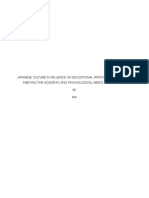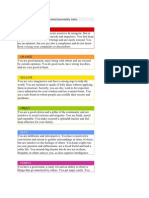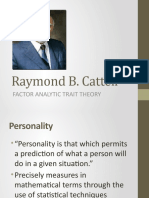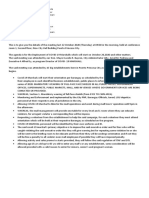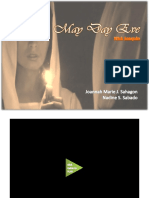Multiple Intelligences Chart
Multiple Intelligences Chart
Uploaded by
Avegail ConstantinoCopyright:
Available Formats
Multiple Intelligences Chart
Multiple Intelligences Chart
Uploaded by
Avegail ConstantinoOriginal Description:
Copyright
Available Formats
Share this document
Did you find this document useful?
Is this content inappropriate?
Copyright:
Available Formats
Multiple Intelligences Chart
Multiple Intelligences Chart
Uploaded by
Avegail ConstantinoCopyright:
Available Formats
Submit
Using Multiple Intelligences in Testing and Assessment
Page 1 of 2 Although Howard Gardner's theory of multiple intelligences (MI) is over a decade old, teachers are still trying to find the best way to use this theory to assess students with different styles of learning and varied academic strengths. Multiple Intelligences shape the way students understand, process, and use information. Gardner groups student capabilities into eight broad categories (each student's unique learning style is a combination of these intelligences): Logical/mathematical (uses numbers effectively) Visual/spatial (is artistically or spatially perceptive) Bodily/kinesthetic (excels at tasks that require physical movement) Musical (perceives and/or expresses musical forms and patterns) Linguistic (uses words effectively) Interpersonal (responds well to others) Intrapersonal (is reflective and inner-directed) Naturalist (makes distinctions in the natural world)
Since no single approach to teaching and assessment can possibly work best for every student, teachers face a challenge. What's the best way to match assessments to students' learning styles? Assessing Multiple Intelligences Of course, assessment should reflect the diversity of intelligences and learning styles in your classroom. For example, students who are good at spatial learning might not display the full range of their knowledge on an essay test. In fact, traditional testing methods are inherently biased in favor of students with strong linguistic and mathematical skills. Advocates of MI theory suggest that teachers supplement their traditional assessment methods with assessment strategies that evaluate student progress in an inclusive, meaningful way. So, how can you use the theory of multiple intelligences to assess student achievement in your classroom? The MI approach to testing is closely related to authentic assessment. This approach enables students to demonstrate the depth of their understanding, connect their classwork to real-life experiences, and apply their knowledge to new situations. MI theorists offer the following tips: Emphasize ongoing assessment and progress. Continue to ask if and how students have improved their skills. Introduce assessment to your students as a regular part of classroom life. Make assessment a part of the learning process, not a stressful, intimidating "event." Try to use instruments, tools, and procedures that embrace some, if not all, of the multiple intelligences.
Use a wide range of assessment tools to measure students' skills and abilities. Give lots of feedback!
Using Multiple Intelligences in Testing and Assessment
Page 2 of 2 Build Your Own Assessment Repertoire To create successful assessment strategies, familiarize yourself with your students' individual learning styles. Knowing how your students learn best can help you choose approaches that will reach them most effectively. Here are some specific strategies that can make assessment productive and fun: Linguistic Ask students to write in a journal regularly. Give oral exams and/or essay tests. Emphasize creative writing have students write poems, plays, and stories.
Logical/Mathematical Assign science labs and experiments. Have students complete logic problems and games.
Bodily/Kinesthetic Challenge students to write and perform plays. Have students build models or use other hands-on techniques to show what they learned.
Visual/Spatial Invite students to create collages, murals, and posters. Encourage students to illustrate their ideas using maps, charts, and graphs. Help students use school equipment to make a video or slide show.
Interpersonal Stage a classroom debate. Have students work collaboratively to brainstorm and prepare a project.
Intrapersonal Ask students to identify their own academic strengths and weaknesses. Have students think of personal goals and give progress reports.
Musical Challenge students to identify and explain patterns in music or poetry.
Ask students to write new lyrics to familiar melodies or to compose a new song.
Naturalist Ask students to keep environmental journals and to share their observations. Invite students to lead classmates on a nature walk to point out interesting plants and animals they found during independent study.
Note that many of these assessment strategies evaluate more than one kind of intelligence. You can use strategies like these and other combinations of projects, performances, and portfolios to assess students' progress. There is no "right" way to use multiple intelligences in testing and assessment. You don't have to overhaul your whole curriculum. But you can make an effort to address each student's strengths and weaknesses by using creative alternatives to traditional testing in your classroom.
Multiple Intelligences Questionnaire
Page 1 of 2 Multiple Intelligences is the theory, created by Howard Gardner, that every person excels at a different type of learning. For an in-depth explanation of the theory, read the Multiple Intelligences Overview. Use the following checklist to determine which intelligence each of your students possesses. Send it home to parents so they can better understand how their child functions and learns in the classroom. Then, check out our other Multiple Intelligences Resources. Linguistic Intelligence Does your child: Enjoy listening to other people talking? Get annoyed with people who use improper English? (for example, He don't know the answer.) Like to learn new words? Give good directions to others so that they understand the first time? Like to tell stories? Enjoy reading books? Have a good memory for names, dates, and trivia?
If this sounds familiar, then your child might someday write a bestseller or become fluent in four languages. Logical-Mathematical Intelligence Does your child: Like to work with computers and calculators? Enjoy math class? Easily add numbers in her head? Enjoy doing science experiments? Ask a lot of questions about how things work?
Enjoy chess, checkers, or other strategy games? Enjoy logic puzzles or brainteasers?
If so, then your child could one day design sky-scrapers or program computers. Spatial intelligence Does your child: Prefer to draw pictures rather than tell stories? Find her way around a new place easily? Like to take things apart and then try to figure out how to put them back together? Read maps, charts, or diagrams more easily than text? Daydream more than peers? Build interesting three-dimensional constructions (like LEGO buildings)? Doodle a lot on notebooks?
If this is your child, then she could grow up to paint a masterpiece or fix car engines. Bodily-kinesthetic Intelligence Does your child: Find activities like riding a bicycle, skating, or walking on a balance beam easy? Use a lot of hand gestures and body movement when talking to friends? Run, swim, and exercise without getting tired? Learn to play new sports easily and quickly? Like to touch something she has just seen? Report different physical sensations while thinking or working? Cleverly mimic other people's gestures or mannerisms? Move, tap, or fidget while seated for a long time in one spot?
If yes, then your child could develop into an expert skier or someone who amuses her friends with hilarious impersonations
Multiple Intelligences Questionnaire
Page 2 of 2 Musical Intelligence Does your child: Enjoy playing a musical instrument? Listen to music a lot? Hum or sing a lot? Cheer herself up with songs when she is sad? Tell you when music sounds off-key? Have a good singing voice? Remember the melodies of songs?
If this is your child, then she may one day conduct a symphony or play in a steel drum band. Interpersonal Intelligence Does your child: Like to work and play with other kids? Understand how friends are feeling by looking at their faces? Have two or more close friends? Give advice to friends who have problems? Have a good sense of empathy or concern for others? Seem to be street-smart? Seem to be a natural leader on teams?
If you answered yes to most of these, your child might become someone's favorite teacher or the CEO of a big company. Intrapersonal Intelligence Does your child: Often need a quiet place to work or just be alone? Like to make collections of things that have special meaning to her? Remember her dreams? Display a sense of independence or strong will? Have a realistic sense of her strengths and weaknesses? Have an interest or hobby that she doesn't talk much about? Accurately express how she is feeling?
Sound familiar? Then your child could someday write great poetry or resist negative peer pressure and do the right thing for herself. Naturalist Intelligence Does your child: Enjoy collecting bugs, flowers, or rocks? Like to closely examine what she finds in nature? Keep detailed records of her observations of nature? Like to watch natural phenomena like the moon and the tides and hear explanations about them? Become fascinated with one particular thing from nature and want to learn about it thoroughly? Want to become a geologist, biologist, or some other type of scientist?
If your answer is yes, then your child could become an expert on paleontology or discover new ways to save the whales. Read more on TeacherVision: http://www.teachervision.fen.com/intelligence/teachingmethods/3678.html#ixzz1tklpyE7X Read more on TeacherVision: http://www.teachervision.fen.com/intelligence/teachingmethods/3678.html#ixzz1tklkBNNv
Read more on TeacherVision: http://www.teachervision.fen.com/intelligence/resource/4933.html#ixzz1tkkGrQdU Read more on TeacherVision: http://www.teachervision.fen.com/intelligence/resource/4933.html#ixzz1tkk6EOmZ
MULTIPLE INTELLIGENCES TEST Where does your true intelligence lie? This quiz will tell you where you stand and what to do about it. Read each statement. If it expresses some characteristic of yours and sounds true for the most part, jot down a "T." If it doesn't, mark an "F." If the statement is sometimes true, sometimes false, leave it blank. 1. _____ I'd rather draw a map than give someone verbal directions. 2. _____ I can play (or used to play) a musical instrument. 3. _____ I can associate music with my moods. 4. _____ I can add or multiply in my head. 5. _____ I like to work with calculators and computers. 6. _____ I pick up new dance steps fast. 7. _____ It's easy for me to say what I think in an argument or debate. 8. _____ I enjoy a good lecture, speech or sermon. 9. _____ I always know north from south no matter where I am. 10. _____ Life seems empty without music. 11. _____ I always understand the directions that come with new gadgets or appliances. 12. _____ I like to work puzzles and play games. 13. _____ Learning to ride a bike (or skates) was easy. 14. _____ I am irritated when I hear an argument or statement that sounds illogical.
15. _____ My sense of balance and coordination is good. 16. _____ I often see patterns and relationships between numbers faster and easier than others. 17. _____ I enjoy building models (or sculpting). 18. _____ I'm good at finding the fine points of word meanings. 19. _____ I can look at an object one way and see it sideways or backwards just as easily. 20. _____ I often connect a piece of music with some event in my life. 21. _____ I like to work with numbers and figures. 22. _____ Just looking at shapes of buildings and structures is pleasurable to me. 23. _____ I like to hum, whistle and sing in the shower or when I'm alone. 24. _____ I'm good at athletics. 25. _____ I'd like to study the structure and logic of languages. 26. _____ I'm usually aware of the expression on my face. 27. _____ I'm sensitive to the expressions on other people's faces. 28. _____ I stay "in touch" with my moods. I have no trouble identifying them. 29. _____ I am sensitive to the moods of others. 30. _____ I have a good sense of what others think of me. Top of page
MULTIPLE INTELLIGENCE SCORING SHEET Place a check mark by each item you marked as "true." Add your totals. A total of four in any of the categories A through E indicates strong ability. In categories F and G a score of one or more means you have abilities as well.
A Linguistic
B LogicalMathematical
C M usical
D Spatial
E BodilyKinesthetic
F Intrapersonal
G Interpersonal
7 ___ 8 ___ 14___ 18 ___ 25 ___
4 ___ 5 ___
12 ___
16 ___ 21 ___ ____
2 ___ 3 ___ 10 ___ 20 ___ 23 ___ ____
1 ___ 9 ___ 11___ 19___ 22___ ____
6 ___ 13 ___ 15 ___ 17 ___ 24 ___ ____
26 ___ 28 ___
27 ___ 29 ___ 30 ___
Totals:
____
____
____
Top of page
The Seven Multiple Intelligences in Children
Children who are strongly: Linguistic Think Love reading, writing, telling stories, playing word games, etc. Need
LogicalMathematical
Spatial
BodilyKinesthetic
Musical
Interpersonal Intrapersonal
books, tapes, writing tools paper diaries, dialogues, discussion, debate in words stories things to explore and think about, experimenting, science materials, manipulatives, by reasoning questioning, figuring out trips to the planetarium and science puzzles, calculating, etc. museum art, LEGOs, video, movies, slides, designing, drawing, in images imagination games, mazes, puzzles, visualizing, doodling, and pictures illustrated books, trips to art etc. museums role play, drama, movement, things through dancing, running, to build, sports and physical games, somatic jumping, building, tactile experiences, hands-on sensations touching, gesturing, etc. learning singing, whistling, via rhythms sing-along time, trips to concerts, humming, tapping feet and music playing at home and school, and hands, listening, melodies musical instruments etc.. by bouncing leading, organizing, friends, group games, social ideas off relating, manipulating, gatherings, community events, clubs, other people mediating, partying, etc. mentors/apprenticeships deeply setting goals, secret places, time alone, self-paced
inside themselves
meditating, dreaming, being quiet,
projects, choices
Top of page
You might also like
- DLL ENG8 1stQ 1st Week CheckedDocument9 pagesDLL ENG8 1stQ 1st Week CheckedAvegail Constantino96% (26)
- The Journey: How to Prepare Kids for a Competitive and Changing WorldFrom EverandThe Journey: How to Prepare Kids for a Competitive and Changing WorldNo ratings yet
- EN7RC-IV-a-3.2: Classify Text Types (Narrative, Expository, Explanation, Recount, Persuasive)Document16 pagesEN7RC-IV-a-3.2: Classify Text Types (Narrative, Expository, Explanation, Recount, Persuasive)Avegail Constantino71% (7)
- DLL ENG8 1stQ 1st WeekDocument8 pagesDLL ENG8 1stQ 1st WeekAvegail Constantino80% (5)
- Intimacy Attitude Scale - RevisedDocument3 pagesIntimacy Attitude Scale - RevisedBasuraNo ratings yet
- 4 Dominant Communication StylesDocument6 pages4 Dominant Communication StylesRenee F Taylor100% (2)
- How Emotionally Intelligent Are YouDocument3 pagesHow Emotionally Intelligent Are YouMaximilian DramescuNo ratings yet
- Reflective Exercise 4 My Self-Assessment With Swot AnalysisDocument11 pagesReflective Exercise 4 My Self-Assessment With Swot Analysisapi-407839349No ratings yet
- Celebrating Differences PDFDocument2 pagesCelebrating Differences PDFapi-375168721No ratings yet
- Personal Effectiveness Test 1Document16 pagesPersonal Effectiveness Test 1Odogbo Elo ClaireNo ratings yet
- Nature of The Learner PDFDocument7 pagesNature of The Learner PDFJennyfer Narciso Malobago100% (1)
- Japanese Cultures Influence On Educational Practices - Its Impact On Meeting The Academic and Psychological Needs of Students Blog Version RaiDocument29 pagesJapanese Cultures Influence On Educational Practices - Its Impact On Meeting The Academic and Psychological Needs of Students Blog Version RaiRai100% (2)
- Independent Learning QuizDocument3 pagesIndependent Learning Quizapi-19508514No ratings yet
- Research PosterDocument1 pageResearch PosterKhairul Anuar Abdul RahimNo ratings yet
- History & Effectiveness of School Counselling in Malaysia - A Critical StudyDocument27 pagesHistory & Effectiveness of School Counselling in Malaysia - A Critical StudyDimana Ada Sungai90% (10)
- Helping Students With Mathematical Disabilities To SucceedDocument12 pagesHelping Students With Mathematical Disabilities To SucceedAsyraf Jamil100% (1)
- The Happiness Institute's Signature Strengths ListDocument2 pagesThe Happiness Institute's Signature Strengths ListCzarPaguio67% (3)
- List of Organizational and Social SkillsDocument2 pagesList of Organizational and Social SkillsAndrei Kolozsvari100% (1)
- Quarter 1 - Module 1: My Study Habits Version 4.0: Rank Learning Style 1 2 3 4 5Document4 pagesQuarter 1 - Module 1: My Study Habits Version 4.0: Rank Learning Style 1 2 3 4 5phoebecruz636No ratings yet
- ADD (ADHD) Self-Report Questionnaire For Teenage/College GirlsDocument25 pagesADD (ADHD) Self-Report Questionnaire For Teenage/College GirlsanonNo ratings yet
- Child Psychology and Parenting StylesDocument24 pagesChild Psychology and Parenting StylesJuma BlakeNo ratings yet
- Purpose: Starting On The Road To Self Discovery A WorksheetDocument2 pagesPurpose: Starting On The Road To Self Discovery A WorksheetDamayanti ThapaNo ratings yet
- Group 1 Assessment of Intimacy in RelationshipsDocument4 pagesGroup 1 Assessment of Intimacy in RelationshipsLester Maniquez100% (1)
- When I Differ With SomeoneDocument3 pagesWhen I Differ With SomeoneSonsern Lin100% (1)
- EQ. QuestionnaireDocument7 pagesEQ. QuestionnaireGokul RungtaNo ratings yet
- Emotional Intelligence Test Unit-2Document3 pagesEmotional Intelligence Test Unit-2Tanu Singh 1584100% (1)
- Influencing Style Questionnaire 2014 PDFDocument7 pagesInfluencing Style Questionnaire 2014 PDFMyOdyssey100% (3)
- Style of LearningDocument20 pagesStyle of LearningSab 1001No ratings yet
- Favourite ColourDocument4 pagesFavourite ColourYasin Zahedi100% (1)
- Lesson 1 Individual Activity Emotional-Intelligence-Eq-AssessmentDocument3 pagesLesson 1 Individual Activity Emotional-Intelligence-Eq-AssessmentDesmond TanNo ratings yet
- LLENARES Listening Skills AssessmentDocument6 pagesLLENARES Listening Skills AssessmentJanica Janica Janica Janica Janica Janica JanicaNo ratings yet
- EFT StrategiesDocument1 pageEFT StrategiesAllen PatrickNo ratings yet
- Secrets of Academic Success From A Professor Who KnowsDocument3 pagesSecrets of Academic Success From A Professor Who Knowsmdmonzurh1100% (1)
- Test:: Are You Assertive?Document7 pagesTest:: Are You Assertive?Neelam ShuklaNo ratings yet
- Anger Exit and Re Entry Routines 1Document3 pagesAnger Exit and Re Entry Routines 1Dunja S100% (1)
- Activity BigFivePersonalityTest ABADocument3 pagesActivity BigFivePersonalityTest ABADana MagalonaNo ratings yet
- Tools For TrainingDocument58 pagesTools For TrainingAnonymous 1sd8foGfGNo ratings yet
- Guide Motivating EmployeesDocument14 pagesGuide Motivating EmployeesJeff LienNo ratings yet
- Raymond B. Cattell: Factor Analytic Trait TheoryDocument16 pagesRaymond B. Cattell: Factor Analytic Trait Theorykatb100% (1)
- The Big 5 Personality TraitsDocument6 pagesThe Big 5 Personality TraitsSHEENA MAE DALGUNTASNo ratings yet
- Stress - Personality Styles and EIDocument24 pagesStress - Personality Styles and EICheri Ho100% (1)
- Interpersonal Skills ExercisesDocument25 pagesInterpersonal Skills ExercisesHasnain Mohammadi100% (1)
- Emotional Intelliegence Scale With TamilDocument10 pagesEmotional Intelliegence Scale With TamilthenimadhavanNo ratings yet
- Via PosterDocument1 pageVia PosterAdriana GeorgescuNo ratings yet
- Personality Assessment - Carreer TestDocument7 pagesPersonality Assessment - Carreer TestboranscribdNo ratings yet
- Action Brainstorming Worksheet UDocument1 pageAction Brainstorming Worksheet UAida IvanNo ratings yet
- Worry Self-Assessment: Harvard Managementor - Managing Workplace Stress ToolsDocument1 pageWorry Self-Assessment: Harvard Managementor - Managing Workplace Stress ToolsCatalina DumitruNo ratings yet
- Worksheet2 Habit 1 Be ProactiveDocument3 pagesWorksheet2 Habit 1 Be Proactiveapi-667709221No ratings yet
- Layer 1 Desire WorkbookDocument4 pagesLayer 1 Desire WorkbookTezcatzinNo ratings yet
- Emotional-Regulation StopDocument2 pagesEmotional-Regulation StopMrEntt100% (1)
- Conflict Resolution ChecklistDocument1 pageConflict Resolution ChecklistThiago RaydanNo ratings yet
- Introduction To The Myers-Briggs Type Indicator: A Leadership Workshop January 26, 2009Document37 pagesIntroduction To The Myers-Briggs Type Indicator: A Leadership Workshop January 26, 2009Emily KohNo ratings yet
- Personality Test: L - B - O - G RDocument2 pagesPersonality Test: L - B - O - G Rapi-509516948No ratings yet
- EmotionalIntelligence 1Document25 pagesEmotionalIntelligence 1ramyashridharNo ratings yet
- Cognitive Behavioural Therapy: Practitioner Certification Socratic QuestioningDocument3 pagesCognitive Behavioural Therapy: Practitioner Certification Socratic QuestioningEddy PopescuNo ratings yet
- Learning Styles Questionnaire Short Version Aug10Document3 pagesLearning Styles Questionnaire Short Version Aug10api-267898429100% (1)
- Belbin's Team Roles - Lec 4Document5 pagesBelbin's Team Roles - Lec 4Tharushi DiyanaNo ratings yet
- Discovering Our Personality Style Through TRUE COLORSDocument3 pagesDiscovering Our Personality Style Through TRUE COLORSmatutina5No ratings yet
- CSP 621 Growth Mindset Lesson PlanDocument4 pagesCSP 621 Growth Mindset Lesson Planapi-548723359No ratings yet
- Values Work Sheet Jan '11Document2 pagesValues Work Sheet Jan '11SupportNo ratings yet
- Via Character Strengths SurveyDocument1 pageVia Character Strengths Surveyapi-316710295No ratings yet
- Comm Styles Survey & NotesDocument11 pagesComm Styles Survey & NotesBiran HeNo ratings yet
- Personality Assessment TestDocument5 pagesPersonality Assessment TestShedy GalorportNo ratings yet
- Adhd HandoutDocument2 pagesAdhd Handoutapi-548854218No ratings yet
- TKT YlDocument12 pagesTKT YlCarolina De Anda MuñozNo ratings yet
- Topic 5. Learning Styles of ChildrenDocument8 pagesTopic 5. Learning Styles of ChildrenMaricel ViloriaNo ratings yet
- How To Make Teaching More Fun and Engaging KodigoDocument3 pagesHow To Make Teaching More Fun and Engaging KodigoShenna OnganizaNo ratings yet
- Module 15 17Document8 pagesModule 15 17Serafina Suzy Sakai100% (2)
- Oral Communication Lesson 4 OkDocument22 pagesOral Communication Lesson 4 OkAvegail ConstantinoNo ratings yet
- HGDG-Proposal Journalism RSPCDocument9 pagesHGDG-Proposal Journalism RSPCAvegail ConstantinoNo ratings yet
- MeetingDocument1 pageMeetingAvegail ConstantinoNo ratings yet
- Teaching Strategies in MathDocument8 pagesTeaching Strategies in MathAvegail ConstantinoNo ratings yet
- Teaching Strategies in MathDocument8 pagesTeaching Strategies in MathAvegail ConstantinoNo ratings yet
- IPCRF With PPST For T1 T3 2018Document17 pagesIPCRF With PPST For T1 T3 2018Avegail ConstantinoNo ratings yet
- Ipcrf CoverDocument19 pagesIpcrf CoverAvegail Constantino100% (1)
- Soul of The Great BellDocument2 pagesSoul of The Great BellGay Delgado86% (22)
- Grade 10 Week 2 Flight of IcarusDocument59 pagesGrade 10 Week 2 Flight of IcarusAvegail Constantino100% (2)
- Learning StylesDocument22 pagesLearning StylesAvegail ConstantinoNo ratings yet
- DLL ENG8 1stQ 2nd Week CheckedDocument6 pagesDLL ENG8 1stQ 2nd Week CheckedAvegail Constantino100% (1)
- Appendix F - Roles and Responsibilities of Teachers and MasteDocument3 pagesAppendix F - Roles and Responsibilities of Teachers and MasteAvegail ConstantinoNo ratings yet
- DLL ENG8 1stQ 3rd WeekfDocument7 pagesDLL ENG8 1stQ 3rd WeekfAvegail Constantino100% (6)
- The Flight of IcarusDocument25 pagesThe Flight of IcarusAvegail ConstantinoNo ratings yet
- Ipcrf CoverDocument19 pagesIpcrf CoverAvegail Constantino100% (1)
- DLL ENG8 1stQ 4th Week CheckedDocument6 pagesDLL ENG8 1stQ 4th Week CheckedAvegail Constantino100% (2)
- Master Teacher1 Official IPCRF 2017-2018Document43 pagesMaster Teacher1 Official IPCRF 2017-2018Avegail ConstantinoNo ratings yet
- May Day Eve AnalysisDocument10 pagesMay Day Eve AnalysisAvegail ConstantinoNo ratings yet
- DLL ENG8 1stQ 5th Week FinalDocument6 pagesDLL ENG8 1stQ 5th Week FinalAvegail Constantino100% (2)
- Eng7 Q4 Ip3 V.02Document5 pagesEng7 Q4 Ip3 V.02Avegail ConstantinoNo ratings yet
- Instructional Plan in English (Grade 7) : #Ixzz3Pzhnknkj AlessaypeerreviewDocument6 pagesInstructional Plan in English (Grade 7) : #Ixzz3Pzhnknkj AlessaypeerreviewAvegail ConstantinoNo ratings yet
- G-10 Macapagal: Quezon National High SchoolDocument7 pagesG-10 Macapagal: Quezon National High SchoolAvegail ConstantinoNo ratings yet
- First Quarter Mastery TestDocument10 pagesFirst Quarter Mastery TestAvegail ConstantinoNo ratings yet
- DLL ENG8 1stQ 2nd Week CheckedDocument5 pagesDLL ENG8 1stQ 2nd Week CheckedAvegail Constantino100% (5)
- 21st Century Lit Topic For MID-TERMDocument54 pages21st Century Lit Topic For MID-TERMAvegail Constantino0% (1)
- Filipino Students Perceptions of Factors Affecting TheirDocument12 pagesFilipino Students Perceptions of Factors Affecting Theircharmela pabillonNo ratings yet
- Secondary Lesson Plan: TH THDocument2 pagesSecondary Lesson Plan: TH THapi-456796301No ratings yet
- Dale's Cone of ExperienceDocument16 pagesDale's Cone of ExperienceKaren Marie Dela PasionNo ratings yet
- Proposal BAB 1-3 NABILA DEVI ASY SYAFA PRINT 1Document28 pagesProposal BAB 1-3 NABILA DEVI ASY SYAFA PRINT 1Ahmada Maghfirotul InayahNo ratings yet
- Teaching A Mixed Ability ClassDocument10 pagesTeaching A Mixed Ability Classmichaelfoy1No ratings yet
- Personal DevelopmentDocument6 pagesPersonal DevelopmentNoman Ul Haq SiddiquiNo ratings yet
- Award in Education and Training PowerPointDocument50 pagesAward in Education and Training PowerPointLuke Dudley100% (1)
- Significance of Mathematical Skils in Earning Business Management in Relation To The Development of Abm StudentsDocument12 pagesSignificance of Mathematical Skils in Earning Business Management in Relation To The Development of Abm StudentsRochelle venturaNo ratings yet
- For Hardbound Rivero Maed P.E Manuscript 072630Document113 pagesFor Hardbound Rivero Maed P.E Manuscript 072630Joshie RiveroNo ratings yet
- Problem and Its BackgroundDocument27 pagesProblem and Its BackgroundJohn Darius LascotaNo ratings yet
- Universal Design For Learning Udl SurveyDocument5 pagesUniversal Design For Learning Udl Surveyapi-426689130No ratings yet
- English Vocabulary Materials in Vocational School Text BookDocument9 pagesEnglish Vocabulary Materials in Vocational School Text BookFull sunNo ratings yet
- Mock Exam and AnswersDocument7 pagesMock Exam and AnswersMichael JohnsonNo ratings yet
- Learning Style SurveyDocument8 pagesLearning Style SurveyPedro HenriqueNo ratings yet
- Internship Portfolio Learning Task 1 12 Ss.y. 22 23Document156 pagesInternship Portfolio Learning Task 1 12 Ss.y. 22 23JenesaNo ratings yet
- Life Skill Activity On Self AwarenessDocument1 pageLife Skill Activity On Self Awarenessapi-200331452No ratings yet
- Dissertation Argosy UniversityDocument8 pagesDissertation Argosy UniversityIDon'TWantToWriteMyPaperSingapore100% (1)
- Visual Learning StyleDocument2 pagesVisual Learning StyleRendre CommissionsNo ratings yet
- Adult Learning: Principles & BarriersDocument25 pagesAdult Learning: Principles & BarriersZareen Tasnim Tapti 2225036080No ratings yet
- Instructor Growth Self-Evaluation Form: Questions For Self-AppraisalDocument5 pagesInstructor Growth Self-Evaluation Form: Questions For Self-AppraisalPetruţa DianaNo ratings yet
- Modules Unit 1-5 TMIGDocument23 pagesModules Unit 1-5 TMIGAlfred Cedrix BornelNo ratings yet
- Gavin Reid - Dyslexia - Meeting The Needs of AllDocument96 pagesGavin Reid - Dyslexia - Meeting The Needs of AllAvril19No ratings yet
- Results For Personality and Learning Styles GTU105 2011Document7 pagesResults For Personality and Learning Styles GTU105 2011Apple'ss HorlickssNo ratings yet
- Free VAK Learning Styles TestDocument2 pagesFree VAK Learning Styles TestFirmanSudrajatNo ratings yet











